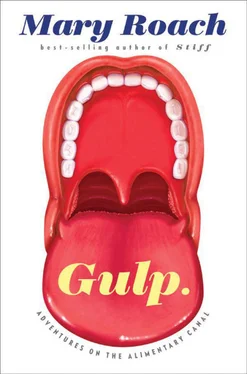Fletcher’s true colors could occasionally be seen through the seams of his cream-colored suits. After bragging, in a 1910 letter, that a family of five could save enough money to furnish a five-room flat in fifteen months by Fletcherizing, he adds, “Of course, the furnishings must be of the simplest sort.” This from a man who lived for years in a suite at the Waldorf Astoria. He summed up his policies at the end of the letter: “Expert economics coming to the assistance of ambitious unintelligence.” Let them chew cake.
The nineteenth and early twentieth centuries saw a cavalcade of possibly well-meaning but probably just greedy individuals attempting to feed the poor on a shoestring budget. In the case of Jean d’Arcet Sr. and Jr., actual leather laces would have provided more nourishment than what the two proposed. In 1817, d’Arcet Jr., a chemist by trade, came up with a method for extracting gelatin from bones (and money from Parisian welfare coffers). Public hospitals and poorhouses, having swallowed the preposterous claim that two ounces of d’Arcet’s gelatin was the nutritional equivalent of three-plus pounds of meat, began serving soup made with the gelatin.
So plentiful were the complaints that in 1831, physicians at an infamous Paris hospital for the poor, Hôtel-Dieu, ran an experiment comparing traditional bouillon with gelatin-based broth. The latter was “more distasteful, more putrescible, less digestible, less nutritious, and… moreover, it often brought on diarrhea.” The French Academy of Sciences sprang into inaction, appointing a committee to look into it. The Gelatin Commission would dither for ten years before finally issuing a thumbs-down. Gelatin fed to animals, the committee reported, was found to “excite an intolerable distaste to a degree which renders starvation preferable.”
Of relevant interest, an 1859 issue of California Farmer and Journal of Useful Sciences offers a recipe [31] “Put 2 and ½ pounds of guano with 3 qts of water in an enamel stew-pan, boil for 3 or 4 hours, then let it cool. Separate the clear liquid, and about a quart of this healthy extract is obtained.” Use sparingly, cautions the author, or it “will be as repugnant as pepper or vinegar.”
for a nutritional extract made from Peruvian seabird guano. While its inventor, a Mr. Win. Clark of England, recommended the elixir “for all classes of society,” he deemed it especially fit for “those who have much exertion and have not the means of buying meat.” Mr. Clark claimed two to three tablespoonfuls was equal to two pounds of meat, with the advantage that it lends to the laborers’ potatoes and peas “a very agreeable taste!”
IN 1979, A pair of Minneapolis researchers put Fletcherism to the test. They brought ten subjects to the local Veterans Administration hospital, and purchased some peanuts and jars of peanut butter. The subjects first ate a diet in which almost all the fat came from peanuts. The peanuts were then swapped out for the peanut butter—an aesthetically acceptable stand-in for excessively chewed peanuts. The subjects’ “digestion ash,” as Fletcher liked to call excrement, was then analyzed to see how much of the peanut fat was leaving the body unabsorbed.
“‘Nature will castigate those who don’t masticate’ may hold some truth,” concluded the paper, which appeared in the October 1980 issue of the New England Journal of Medicine. On the whole-peanut diet, the subjects excreted 18 percent of the fat they’d consumed. When they switched to peanut butter, only 7 percent escaped in their stool.
But peanuts are hardly representative of the average food. Everyone knows—via “visual observation of stool samples,” to use the New England Journal of Medicine ’s way of saying “a glance before flushing”—that chunks of peanuts make their way through the alimentary canal undigested. Nuts are known for this. Peanuts (and corn kernels) are so uniquely and reliably hard to break down that they are used as “marker foods” in do-it-yourself tests of bowel transit time [32] The human digestive tract is like the Amtrak line from Seattle to Los Angeles: transit time is about thirty hours, and the scenery on the last leg is pretty monotonous.
—the time elapsed between consumption and dismissal. Peanuts are the food singled out for this trait by Martin Stocks, business development manager for the Model Gut, a computerized tabletop digestive tract [33] “It can even vomit,” boasts its designer. No reply arrived in response to an e-mail asking whether and into what the Model Gut excretes.
that can be hired out for absorption studies.
I had contacted Stocks to see if it might be possible to engage the Model Gut for a test of Fletcherism. It was, but would “likely run into the $10,000 to $20,000 range.” Stocks’s opinion was that with a few recalcitrant foods—here he singled out nuts and rare or raw meat—extensive mastication (chewing) might make a small difference in how much energy and nutrients are absorbed, but that it was “unlikely to have a dramatic effect on one’s overall nutritional intake.”
Stocks passed my e-mail along to Model Gut senior scientist Richard Faulks. Faulks was dismissive not only of extreme chewing, but also of the related fad for blenderizing to increase the accessibility of nutrients. It’s true saliva carries an enzyme that breaks down starch, but the pancreas makes this enzyme too. So any digestive slack caused by hasty chewing would be taken up in the small intestine. The human digestive tract has evolved to extract the maximum it can from the food ingested, Faulks said, and that is probably all it needs. “Nutritional science is dogged by the idea that if some is good, more is better,” he said, “and this has led to the belief that we should endeavor to extract as much as possible of whichever fashionable component is in vogue. This is to ignore evolutionary biology and the imperative of survival.” He pretty much ran Horace Fletcher through the Model Gut.
One thing to be said in favor of thorough chewing is that it slows an eater down. This is helpful if that particular eater is trying to shed some weight. By the time his brain registers that his stomach is full, the plodding thirty-two-chews-per-bite eater will have packed in far less food than the five-chews-per-bite wolfer. But there’s thorough and there’s Fletcher. Chewing each bite, say, a hundred times, Faulks said, could have the opposite effect. It would lengthen the meal so radically that the stomach could have time to empty the earliest mouthfuls into the small intestine, while the last mouthfuls are still on the table. Thereby making room for more. Fletcherizers’ meals could conceivably be so interminable that by the time they finally cleared their plate and set down their napkin, they’d already be feeling peckish again.
Not to mention, the morning’s half gone. “Who has time for this?” was the reaction of Jaime Aranda-Michel, a gastroenterologist with the Mayo Foundation, when I called to ask him about Fletcherizing. “You’re going to spend all day just having breakfast. You will lose your job!”
LONG BEFORE DIGESTION researchers had veterans’ stool and Model Guts to play with, they had Alexis St. Martin. In the early 1800s, St. Martin worked as a trapper for the American Fur Company in what is now Michigan. At age eighteen, he was accidently shot in the side. The wound healed as an open fistulated passage, the hole in his stomach fusing with the overlying holes in the muscles and skin. St. Martin’s surgeon, William Beaumont, recognized the value of the unusual aperture as a literal window into the actions of the human stomach and its mysterious juices, about which, up until that point, nothing much was known.
Читать дальше












